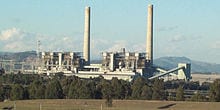AGL Energy has continued to rubbish suggestions from members of the Coalition, as well as the Murdoch media and the ABC, that Australia should invest in new baseload generation, particularly in coal plants.
“We just don’t see the development of a new coal-fired power plant as economically rational, even before carbon costs,” AGL Energy CEO Andy Vesey told analysts and journalists at a briefing on Thursday, to mark the release of its annual profit results.
And nor would the company consider extending the life of existing coal-fired generators, such as the Liddell plant in the NSW Hunter Valley, which is scheduled to close in 2022.

AGL made a point in its presentation that the most economic option to replace the 2000MW Liddell would not be coal, or baseload gas, but a mix of energy from wind and solar, and various load shaping and firming capacity from other sources.
This could include battery storage, pumped hydro, demand response mechanisms, and gas peaking plants. It confirmed it is looking at all possibilities but it highlights the shift from reliance on “baseload” power, which as we saw last summer does not equate to reliability, and dispatchable generation.
Already, the 200MW Silverton wind farm is under construction near Broken Hill, and the 465MW Coopers Gap wind farm in Queensland is expected to begin construction soon. Vesey said this would provide “clean reliable energy” for the grid.
AGL also reproduced its estimates of the current cost of wind and solar PV. Both renewable energy technologies delivered energy at a lower cost than brown or black coal, and were still competitive even after adding “firming costs”.
These estimates do not include carbon risk, and the only thing stopping increased investment in those technologies was the lack of policy certainty, Vesey said.
“The challenge is that we are at a point where the lack of certainty around carbon policy is preventing people from investing in the right options, which we think is wind, solar, and storage,” he said.
Asked if the company would extend Liddell, built in 1973, particularly given the windfall earnings from the ageing and fully depreciated coal plants in its portfolio given the high wholesale prices, Vesey said no.
Even without factoring in the carbon risk, it would require significant investment in an asset that would be less reliable and have higher cost than other possibilities, such as renewables.
Indeed, Liddell only operated at a capacity factor of 50 per cent in the last financial year, barely above the best performing wind farms.
Notably, half of its capacity was not available during the supply crunch of the NSW heat wave, when wind and solar saved the day after the state’s two biggest gas generators also crashed.
The Bayswater plant operated at 64 per cent capacity, while Loy Yang A operated at around 75 per cent.











